yesterday's tennessee

Henderson County Times Community History Series
Henderson County Times
May 28, 1980
Middlefork, Tennessee, is situated 10 miles south of Lexington on Highway 22A. It originally was a crossroads of the Lexington-Purdy Road (present 22A) and the Mifflin-Saltillo Road (present Middlefork-Mifflin Rd.). The community took its name from the Middle Fork Creek of the South Fork of the Forked Deer River, but is commonly known to many people as "Lizard Lick". Legend goes that the name was derived from an old salt lick in the area.
The first recorded settler of Middlefork was John Crook, who arrived there in 1820 from Bedford County, TN, by land grant from the State of Tennessee. Not much else is known from 1820 to 1830, but it seemed to be a time of great growth. Some settlers, like John Crook, brought their slaves with them to help in the building of houses, other came alone and sent for their families later. Sam settlers who arrived before 1830 included Charles Riddle, Joel Hurt, James McAdmas, Silas Grider, William Arnold, Thomas Dodds, and W. H. Griswell. Many were from North Carolina but some of these founding fathers made their way over directly from Spartanburg County, South Carolina, being descended from ancient families in that state. Other names like Beaver, Carver and Seyrnour also fill the lists of Pre-1830 settlers.
Another early settler was Jeremiah Hendrix, who ran a water mill near Middle Fork Creek. He also has one of the earliest tombstones in this area as he was buried in the Hendrix Graveyard on January 28, 1828. In 1834, Nichoclas Garrett and Frederick Phelps also joined the Middlefork community, both which are remembered by cemeteries that bear their names. James Ryals and Green McAdams came to the community soon after, with McAdams erecting a wool carding mill before 1850. James moss settled here also, but dies in 1843, being the earliest known grave at Old Big Springs Cemetery.
As the 40's rolled into the 50's, the population continued to grow. By 1860, it included well over 800 people; and had evolved into a very pr0-Southern agriculturally minded community, with the wealthier families procuring slaves to tend the house and help in the field: there were few paid overseers there as everyone in the family took some part in making the crop. By this time it could boast several stores, two blacksmiths, V. B. Garrett and J. W.Dodds; two carpenters; J. McGraw and William Wallace; one brick mason, Millinder Cox, two school teachers, E. Anderson and M..C. Stegall; one miller, J. B. Wallace; one boot and shoe maker, Elias Stewart; one granary keeper, Joseph S. Hamilton; one Postmaster, J. S. Ross; a doctor's office and a cotton gin . And, although most clothes were made by individual families, the town included four spintress's and a seamstress.
Very soon most of the male population would march off to join the army during the War Between the States, all but a few being included in the ranks of the Army of the Confederate States in order to defend their homeland. Middle Fork Creek seemed to be a dividing line in Henderson County; with most of the people north and east of it favoring the union, and those below it favoring the South. However, some decided their loyalty was still with the United States, and it caused great rifts in families. One suck instance was the Meadows family, where one son, Jonas, joined the invading foe and the other son, James, joined the army of Rebellion. Both survived the War, but wouldn't speak to one another until well into their old age when they decided to bury the hatchet.
Among those who sided with their Southern brethren were T. G. Crook, Wiley M. Crook, Elijah H. Crook, Joseph H. Rylas, and Henry Carver, who would give his life as early as July of 1861. Many other citizens of Middlefork also fell, such as John Nesbit, Zach Dodds, John S. Brower, and James R. Arnold, who all met their death in the Battle of Tishomingo Creek, Miss. One other, Eli Arthur Reid, was wounded at the battle, having a Union bullet glance off his skull causing an indentation large enough to set a small ball or egg in, in which he could walk across a room and it would balance perfectly.
Middlefork suffered more atrocities at home from neighboring communities than it did on the battlefield. One such instance involved young Lt. James Wills Dodds, C.S.A., who was "captured and brutally murdered"; as his tombstone at Unity Cemetery will attest. On March 9, 1864, the young soldier was walking between Middlefork and Huron in his gray uniform. He was then set upon by Union sympathizers and they ravaged him by cutting off his ears, and silencing his cries by cutting out his tongue, and mutilated him in manner to be brutal. His devoted brother later found him in a thicket being devoured by hogs.
In another instance Colonel Fielding Hurst of Montezuma marched from Purdy to Lexington, through Middlefork cutting off the heads of Confederate sympathizers and placing them on each of the mile markers.
A small skirmish was also fought at the "Lick" in and around the present home of Mr. Earl Tignor. There were only a few boys on each side, but it ended up with the Yankees capturing a couple of the rebels guns, which they took to the blacksmith shop and proceeded to bend the barrels. The late Mr. George Arnold and a companion, having the curiosity of most young boys, took one of the weapons and managed to straighten out the barrel. They then tied it to a tree and rigged the trigger with a string to fire it, neither being willing to hold it. It fired, scaring the boys, and blowing a hole in a fencepost. Numerous stories are also told of how the air seemed to vibrate with the sound of thunder during the battle of Shiloh. One boy, wanting to join the conflict, got as far as Jack's Creek before the sounds of the guns scarred him enough to prompt him to return home, but being tired he stayed the night curled up in a hollow tree.
The war finally ended; and the men then turned their attention to making a crop instead, of making war. Reconstruction was comparatively quiet except for the adventures of Hugh E. Crook, who led his vigilante group to keep law and order. This was usually done by an ominous warning, but sometimes he resorted to the noose, having at one known time hung a man at Hinson Springs, and at other times meeting out such justice to fugitives from the law as he saw fit.
The main records at this time are from Big Springs School, where five grades were taught at subscription rates from very early times until about 1898. One of the teachers was Jim Reid, who was one of the very few teachers that the more rowdier boys didn't manage to run off. Another was Dr. John W. Sparkman who taught there from July 1896 to January of 1898. The school had been held as long as anyone could remember at the Old Big Springs Presbyterian Church. When the congregation moved to another spot sometime after 1885, the old building was left for the school. However, sometime after 1898 a school was built closed to the "Lick", between the old home place of W. C. Crook and one of his seed houses. One of the teachers there was Mr. Charlie Pittman and his brother. Later a new building was built at the present school site sometime prior to 1916. This in turn was redone and when the number of pupils increased it was remodeled to accommodate two teachers. Middifork school taught all eight grades, and before it was consolidated into South Haven school, it had managed to be certified to teach two years of High School, the other two having to be taken at Lexington. The Middlefork School building is now [1980] the residence of Mr. Tray Ryals.
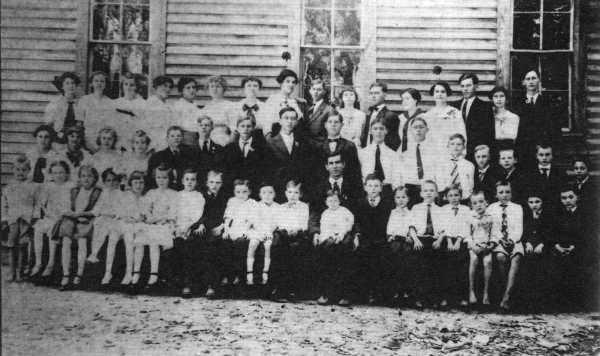
Middlefork school about 1917. Some living members [1980] from this class
are:
(bottom row, L to R) No. 1 E. E. Kee, No. 3 Pearl Crook Brown, No. 14 Troy
Ryals, No. 15 Clyde Crook,
Nos. 21 and 22 Harold and Edwin Bell. The teacher, W. C. Crook, sits with his
son Robert in his lap.
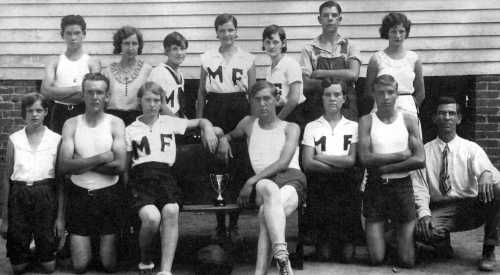
The Middlefork Basketball Team of 1931, with their championship trophy and
ball.
W. C. Crook was teacher and coach.
Around the turn of the century, Middlefork again became prosperous. The cotton gin, which had always been an integral part of the community was in full operation. W. C. Crook, and his brothers, T. J. and B. E. Crook, ran store that would be the root of four farm industries, Crook Bros. Seed Co., W. C. & R. L. Crook Seed, T. J. Crook and Sons Seed Co., and finally in 1952, the Crook Delinting and Seed Treatment Co., now [1980] owned and operated by Wadley family since 1972. Out of these organizations came Crook's Prolife White Giant Seed Corn, Half & Half Cotton Seed, Empire Cotton and D. P. &. L Cotton seed. In 1929, Crook Bros. sold and shipped more seed than anywhere else in the United States and has had orders for seed as far away as the British Honduras. Because of the business, the Crook Bros, bought an electric generator in 1916 which was composed of a gasoline engine, a generator and 56 glass Delco batteries. This provided electricity to two houses and the business, and before 1920 they bought enough wire and poles to run their own telephone line to Lexington.
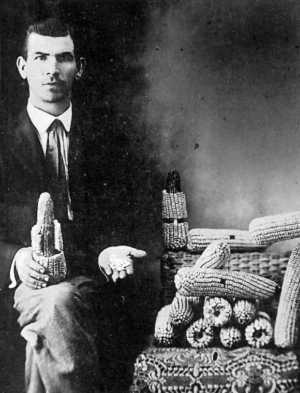
These 14 ears of Crook Prolife White Giant Seed Corn
were weighed on Nov. 10, 1909, at 24½ lbs. When
thoroughly dry. 46 ears would shell one bushel of seed
corn. The ears themselves averages 13 inches long and
11 inches in circumference.
Also at this time, Middlefork was serviced ‘by the Crook Bros. Store that sold everything from silk hose to coffins: Arnold's store, which was also the office of Dr. Arnold, and the Wadley Gristmill, owned and operated by J. R. "Dyke" Wadley. He had at first built a. mill at Huron but later built one at Middlefork. He had a toll box there in which he took out a percentage of corn as payment. It was a regular Saturday affair to shell a "turn of corn " to cart to "Dyke" Wadley' s mill.
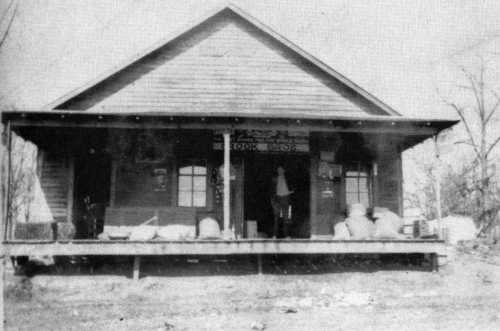
Crook Bros. Store in 1916. 22A runs in front of the store, and the
Middlefork-Mifflin
Road runs down the right side. T. J. Crook stands in the door.
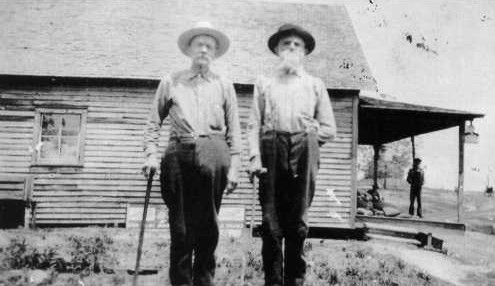
A side view of Crook Bros. Store, showing wagons on what is now 22A and to
the far
right is part of the Wadley Gristmill. Joseph Ryals, a confederate veteran,
and
W. B. Crook stand in the foreground.
W. T. Bell, Sr. operated a small 8 x 10 foot barber shop for 10 cents a haircut, but when he started charging 15 cents he lost a lot of business because they thought 15 cents was entirely too much. However, he was closed down later because he wouldn't bother to buy a license to cut hair.
Besides Dr. John Arnold, Dr. Robert Lee Smith also served the community, being a well-learned and amiable man from Decatur County, Tenn. He could always be seen driving from place to place in his little black buggy.
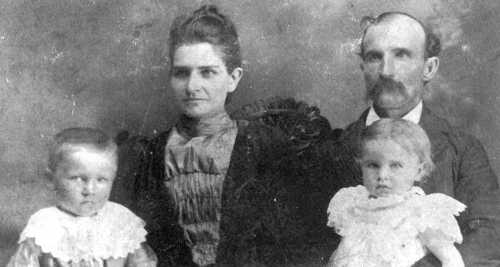
This is one of the community doctors and his family. From left to right: Bob
Smith, Nancy
Crook Smith, Dr. Smith and Mary Bell Smith, about 1890.
A dentist, Dr. John W. Sparkman, also took residence at Middlefork, with the back room of his house serving as an office. He had all the latest equipment in dentistry including a dentist chair, gas lights and a large assortment of instruments for fixing and making teeth, which, some said worked better than their originals. A post office was kept around this time by Fred McAdams in his home.
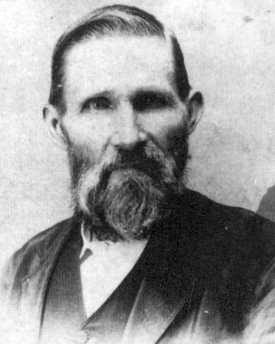
Dr. John W. Sparkman, dentist, teacher,
and ex-confederate soldier.
For entertainment the community was not lacking either. Above Dr. Arnold's store was a Woodmen of the World Lodge, of which a ritual book and sward still exists. Circuses also came through quite often. One circus was only, supposed to stay for two days, but the crowds were so large that it stayed for over two weeks. It has a small assortment of animals, including a bear that the community boys liked to wrestle. Also with the circus were acrobats whose stunts and feats of daring amazed all from the youngest to the eldest in the crowds.
|
Bro. And Sister Parish from Jackson stand in front of |
The clash of an era--T. J. Crook and companion sit in a buggy |
During part of the Depression a Mr. Bradley, along with others, would come to Middlefork School to show silent movies. As admission they would charge a small fee like a nickel of dime, or in place of money they would accept food like a sack of potatoes or some poultry.
Whenever there was a Vacation Bible School at Unity Church, the school would also open its doors for those who could not travel as conveniently as others to Unity. At one time, Sunday School was held here for those further away from the church house.
Stage productions were also carried am at the school for the adults. One time during the Depression a Miss Powel came up for Florida just to coach a two night play here. Miss Powel who has oftentimes been described as young and beautiful, turned out a magnificent production of "Miss Blue Bonnet", in which "Peewe" Clinton Kee was the Star. The adults, and children as well, came in and around the school to watch the stage play both nights.
Besides the entertainment at the school and the seasonal circuses, the young people would gather at Willie Rhodes' store on Sunday afternoons to carry out their courtships. Many a lad has found his way to the altar by staying too long around Rhodes' Grocery. The 40's were a good time and besides Rhodes' Store, Odell Sparkman's Grocery was around for awhile. In 1940, C. M. Mullins bought him out and built a new store in 1951. In 1979 this was sold and is partially remodeled under the name of Tignor and Sons. Another store in Middlefork was run by T. P. Ryals, as well as a garage. He died later but the old store still stands. About 1972 a new store was built next to the H & H Grocery, owned and operated by Mr. and Mrs. J. B. ____
[last column accidentally not copied]
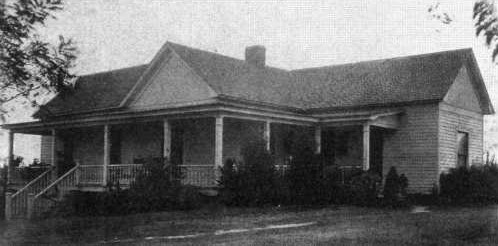
The W. C. Crook House, built in 1916 and still stands today. Former Governor
Gordon
Browning, as well as many representatives and Senators, have eaten here. In the
front yard
W. C. Crook held Court while he was magistrate in the 30's.
The Sparkman Store in the 1930's.
The largest house ever built in Middlefork was the T. J. Crook home built in the 1910's. It burned in the late 1930's. The boys are, (L to R) Robert Crook, Fred Crook, Clyde Crook, and unknown person.
The Willie Rhodes Store was a landmark of Middlefork. It was torn down in the 1970's. T. J. Crook, whose sons built the store, stands in the fireground.
Mullins Grocery in 1951. Charlie and Dennis Mullins stand in front.
Middlefork School in 1931. W. C. Crook, teacher and principal.
History: Middlefork, A Forgotten Community, W. Clay Crook
Photographs: Historic Photographs of Middlefork, Middlefork, October 1999 (photo essay), Middlefork School Basketball Teams circa 1930-1931
Cemeteries: Chester County - Hamlett (with photographs), Hurt (with photograph), Rhodes (with photograph), Unity; Henderson County - Big Springs (with photograph), Garrett (with photographs), Hendrick (with photograph), Middlefork, Old Big Springs, Phelps
Maps: Map of Middlefork and Jacks Creek, Map of William L. Smith Farm and John Crook Land Grants
top · home · yesterday's · families · schools · links · what's new · memorial · about
This site was created by David Donahue and Brenda Kirk Fiddler.
This site is currently maintained by Jerry L. Butler
Copyright © 2004 - 2010, All rights reserved